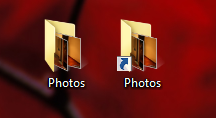In Windows, you can create your own keyboard shortcuts to launch frequently used programs or to open commonly used files and folders, as long as there is already a shortcut icon to it.

If you are not sure what a shortcut is, a shortcut is an icon which links to a program, file or folder on your hard disk. Windows differentiates shortcuts from the actual files by adding a small arrow in the corner of shortcut icons (exception: most, if not all icons in the Start menu are shortcuts, however they do not have the small arrow). In this picture on the right, the icon on the left is the
actual Photos folder, whereas the icon on the right is a
shortcut to the Photos folder on the left. Double-clicking on either icon will open the Photos folder. Deleting the shortcut will not delete the Photos folder; deleting the Photos folder will break the shortcut (there is nowhere for the shortcut to point to). Also you can rename the shortcut to anything you like, say "Open Photos folder", but if you rename the original Photos folder, the shortcut will break too.
With that in mind, let's get to the part where we create the keyboard shortcuts:
- Right-click on any shortcut icon on your Desktop, in your Start menu or anywhere. Remember: the icons in your Start menu are shortcuts, even if they don't have the shortcut arrow.
- Click Properties. The window on the right will appear.
- You can see that the value of Shortcut key is currently None. To define a shortcut key, click in the Shortcut key field, then simply press any letter or number key on your keyboard. The default shortcut combination will be Ctrl + Alt + <whatever key you pressed>.
- Click Apply.

-
(Windows Vista and Windows 7) A prompt saying that you need to provide administrator permission will pop out. Click on Continue. Windows Vista may further prompt you with a User Account Control prompt, asking for permission to continue. Make sure that the action says "Save Shortcut Properties, Microsoft Windows", and click on Continue again.
- Click OK. Done.
If you only pressed a single letter or number key, Windows will prepend
Ctrl + Alt + to your keyboard shortcut. The reason behind this is because most combinations of
Ctrl + something and
Alt + something are already used by other programs. You can use other modifier key combinations listed below, but you will need to manually press the modifier keys (the modifier keys are Ctrl, Alt, Shift).
- Ctrl + Alt + any letter or number
- Ctrl + Shift + any letter or number
- Shift + Alt + any letter or number
- Ctrl + Shift + Alt + any letter or number
 |
| The function keys are on the top row of your keyboard. |
Apart from letters and numbers, you can also use the Function keys (F1 to F12) on the topmost row of your keyboard. Windows allows you to create shortcuts using Function keys with the following modifier keys:
- Ctrl + function key
- Shift + function key
- Alt + function key
- Shift + Alt + function key
- Ctrl + Alt + function key
- Ctrl + Shift + function key
- Ctrl + Shift + Alt + function key
- No modifier key, just the function key alone (not a good idea, since some of the function keys already do something)
(in other words you can use any combination of modifier keys you like for keyboard shortcuts using function keys)
One thing that gripes me is that
Windows won't tell you that your shortcut key is already used as a default Windows shortcut key. For example, Windows won't stop you from using
Alt + F4 as a shortcut to launch your web browser (Alt + F4 is used to close programs or shutdown Windows). To avoid running into such clashes, it is better you use modifier keys for shortcuts using the function keys (e.g.
Ctrl + F12). For your reference, here's a
list of what the function keys already do.
If you want to create a keyboard shortcut for a file or folder, you must already have a shortcut icon to that file or folder somewhere. To create a shortcut icon, hold on to
Alt, then drag and drop the file or folder to where you want the shortcut icon to be.
Lastly, if you want to remove a keyboard shortcut you have created, simply open the Properties window of the shortcut icon, then press
Backspace or
Delete in the Shortcut key field and it should revert back to "None".



No comments :
Post a Comment
All comments are subject to moderation. If you don't want to sign in, comment as "Name/URL".